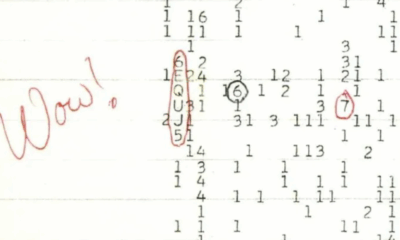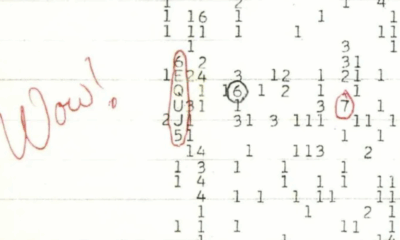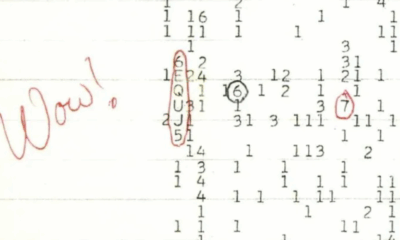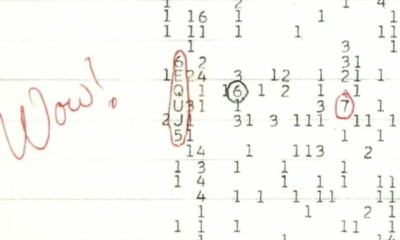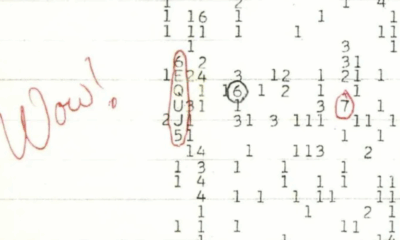Science
Scientists Identify Natural Source of 1977 Alien Radio Signal

A radio signal detected in 1977, once deemed a potential sign of extraterrestrial life, has likely been traced to a natural origin, according to recent research led by Dr. Antonio Paris of the Planetary Science Institute. The signal, famously known as the “Wow! signal,” was detected by the Big Ear radio telescope at Ohio State University and has intrigued scientists for decades.
Dr. Paris’s study suggests that the Wow! signal may actually be a type of natural phenomenon called a Fast Radio Burst (FRB). These bursts are powerful, millisecond-long flashes of radio waves that occur across the universe. The research indicates that the signal could have originated from a massive cloud of hydrogen located in the Milky Way galaxy, rather than from an extraterrestrial civilization.
In his analysis, Dr. Paris examined the frequency and structure of the signal, comparing it to known FRBs. He concluded that the characteristics of the Wow! signal align closely with those of these cosmic events, which are believed to be generated by rapidly rotating neutron stars or collapsing massive stars.
The Wow! signal was first detected on August 15, 1977, during a SETI project aimed at finding signs of intelligent life beyond Earth. The 72-second signal, which appeared to come from the Sagittarius constellation, sparked excitement in the scientific community and led to numerous theories about its origin.
Despite initial speculation regarding its extraterrestrial nature, subsequent investigations have struggled to replicate the signal or clearly identify its source. The latest findings by Dr. Paris offer a plausible explanation that shifts the narrative back toward natural cosmic phenomena.
This discovery highlights the ongoing challenges and complexities associated with identifying and interpreting signals from space. The search for extraterrestrial intelligence continues to be a critical area of research, with scientists employing advanced technology and methodologies to analyze cosmic signals.
As the field of astrophysics evolves, researchers remain vigilant, utilizing new tools and techniques to enhance our understanding of the universe. The Wow! signal, while likely of natural origin, remains a symbol of humanity’s quest to explore the unknown and seek answers beyond our planet.
The implications of this research extend beyond the Wow! signal alone, as it opens up further inquiries into the nature of FRBs and the processes that generate them. Scientists are keen to study these enigmatic bursts more closely, as they may hold clues to the dynamics of cosmic events and the evolution of galaxies.
In summary, the re-evaluation of the 1977 Wow! signal not only provides insight into its likely natural origins but also reinforces the importance of continued exploration and investigation in the field of space science. The quest for knowledge about the cosmos remains as essential as ever, with each discovery bringing us closer to understanding the vast universe we inhabit.
-

 World1 week ago
World1 week agoPrivate Funeral Held for Dean Field and His Three Children
-

 Top Stories2 weeks ago
Top Stories2 weeks agoFuneral Planned for Field Siblings After Tragic House Fire
-

 Sports3 months ago
Sports3 months agoNetball New Zealand Stands Down Dame Noeline Taurua for Series
-

 Entertainment3 months ago
Entertainment3 months agoTributes Pour In for Lachlan Rofe, Reality Star, Dead at 47
-

 Entertainment2 months ago
Entertainment2 months agoNew ‘Maverick’ Chaser Joins Beat the Chasers Season Finale
-

 Sports3 months ago
Sports3 months agoSilver Ferns Legend Laura Langman Criticizes Team’s Attitude
-

 Sports4 weeks ago
Sports4 weeks agoEli Katoa Rushed to Hospital After Sideline Incident During Match
-

 Politics2 months ago
Politics2 months agoNetball NZ Calls for Respect Amid Dame Taurua’s Standoff
-

 World2 weeks ago
World2 weeks agoInvestigation Underway in Tragic Sanson House Fire Involving Family
-

 Top Stories2 weeks ago
Top Stories2 weeks agoShock and Grief Follow Tragic Family Deaths in New Zealand
-

 Entertainment3 months ago
Entertainment3 months agoKhloe Kardashian Embraces Innovative Stem Cell Therapy in Mexico
-

 World4 months ago
World4 months agoPolice Arrest Multiple Individuals During Funeral for Zain Taikato-Fox

